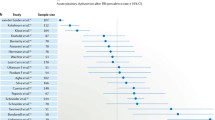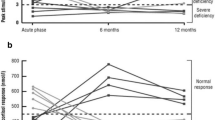Abstract
Traumatic brain injury is one of the main causes of death, as well as, physical and cognitive disabilities in young adults. Recent studies have demonstrated head injury (TBI and SAH) as a frequent cause of hypopituitarism. Since hormonal deficits may contribute to the outcome of the patient, it is important to establish guidelines of who, when, and how to treat. The probability of developing hypopituitarism has been based on the severity of the TBI. Yet discrepancies in recent studies display that minimal TBI can also result in hypopituitarism. Thus patients with moderate to severe TBI must be screened and those with minimal TBI monitored for hypopituitarism. The temporal relationship between TBI and occurrence of hypopituitarism is observed in 3 phases-acute, recovery, and chronic. Clear hormonal deficits should be treated, but the question arises concerning subtle abnormalities and their role in the outcome of TBI patients.
Similar content being viewed by others
References
Salazar AM, Warden DL, Schwab K, Spector J, Braverman S, Walter J, Cole R, Rosner MM, Martin EM, Ecklund J, Ellenbogen RG. Cognitive rehabilitation for traumatic brain injury: A randomized trial. Defense and Veterans Head Injury Program (DVHIP). Journal of the American Medical Association 2000;283:3075–3081.
Colantonio A, Dawson DR, McLellan BA. Head injury in young adults: Long term outcome. Archives of Physical Medicine and Rehabilitation 1998;79:550–558.
Morton MV, Wehman P. Psychological and emotional sequelae of individuals with traumatic brain injury: A literature review and recommendations. Brain Inj 1995;9:81–92.
Consensus Conference. Rehabilitation of persons with traumatic brain injury. NIH Consensus Development Panel on Rehabilitation of Persons With Traumatic Brain Injury. Journal of the American Medical Association 1999;282:974–983.
Bondanelli M, de Marinis L, Ambrosio MR, Monesi M, Valle D, Zatelli MC, Fusco A, Bianchi A, Farneti M, degli Uberti EC. Occurrence of pituitary dysfunction following traumatic brain injury. Journal of Neurotrauma 2004;21(6):685–696.
Aimaretti G, Ambrosio MR, Di Somma C, Fusco A, Cannavo S, Gasperi M, Scaroni C, De Marinis L, Benvenga S, degli Uberti EC, Lambardi G, Mantero F, Martino E, Giordano G, Ghigo E. Traumatic grain injury and subarachnoid haemorrage are conditions at high risk for hypopituitarism: Screening study at 3 months after brain injury. Clinical Endocrinology 2004;61:320–326.
Aimaretti G, Ambrosio MR, Di Somma C, Gasperi M, Cannavo S, Scaroni C, Fusco A, Del Monte P, De Menis E, Faustini-Fustini M, Grimaldi F, Logoluso F, Razzore P, Rovere S, Benvenga S, degli Uberti EC, De Marinis L, Lombardi G, Mantero F, Martino E, Giordano G, Ghigo E. Prospective study about brain injury-induced hypopituitarism: Residual pituitary function may improve or more rarely worsen over 12 month follow-up. Journal of Clinical Endocrinology and Metabolism 2005 (in press).
Lieberman SA, Oberoi AL, Gilkinson CR, Masel BE, Urban RJ. Prevalence of neuroendocrine dysfunction in patients recovering from traumatic brain injury. Journal of Clinical Endocrinology and Metabolism 2001;86(6):2752–2756.
Agha A, Rogers B, Mylotte D, Taleb F, Tormey W, Phillips J, Thompson CJ. Neuroendocrine dysfunction in the acute phase of traumatic brain injury. Clinical Endocrinology 2004;60:584–591.
Kelly DF, Gaw Gonzalo IT, Cohan P, Berman N, Swerdloff R, Wang C. Hypopituitarism following traumatic brain injury and aneurysmal subarachnoid hemorrhage: A preliminary report. Journal of Neurosurgery 2000;93:743–752.
Edwards OM, Clark JDA. Post-traumatic hypopituitarism: Six cases and a review of the literature. Medicine 1986;65:281–290.
Benvenga S, Campenni A, Roggeri R, Trimarchi F. Hypopituitarism secondary to head trauma. Journal of Clinical Endocrinology and Metabolism 2000;85(4):1353–1361.
Dimopoulou I, Tsagarakis S, Theodorakopoulou M, Douka E, Zervou M, Kouyialis AT, Thalassinos N, Roussos C. Endocrine abnormalities in critical care patients with moderate-to-severe head trauma: Incidence, pattern and predisposing factors. Intensive Care Medicine 2004;30:1051–1057.
Teasdale G, Jennett B. Assessment of coma and impaired consciousness. A practical scale. Lancet 1974;2:81–84.
Greenwald BD, Burnett DM, Miller MA. Congenital and acquired brain injury. 1. Brain injury: Epidemiology and pathophysiology. Archives of Physical Medicine and Rehabilitation 2003;84:S3–S7.
Marshall LF, Marshall SB, Klauber MR, Van Berkum Clark M, Eisenberg H, Jane JA, Luerssen TG, Marmarou A, Foulkes MA. The diagnosis of head injury requires a classification based on computed axial tomography. Journal of Neurotrauma 1992;9:S287–S292.
Bruns J Jr, Hauser WA. The epidemiology of traumatic brain injury: A review. Epilepsia 2003;44(Suppl 10):2–10.
Harad FT, Kerstein MS. Inadequacy of bedside clinical indicators in identifying significant intracranial injury in trauma patients. Journal of Trauma 1992;32(3):359–366.
Kornblum RN, Fisher RS. Pituitary lesions in craniocerebral injuries. Archives of Pathology 1969;88:242–248.
Crompton MR. Hypothalamic lesions following closed head injury. Brain 1971;94:165–172.
Cytowic RE, Smith A. Transient amenorrhea after closed head trauma (Letter). New England Journal of Medicine 1986;314:715.
Chiolero R, Berger M. Endocrine response to brain injury. New Horizon 1994;2:432–442.
Casanueva FF, Ghigo E, Popovic V, The Athens TBI and Hypopituitarism Study Group. Hypopituitarism following traumatic brain injury (TBI): A guideline decalogue. Journal of Endocrinology Investigations 2004;27:793–795.
Leal-Cerro A, Flores JM, Rincon M, Murillo F, Pujol M, Garcia-Pesquera F, Dieguez C, Casanueva F. Prevalence of hypopituitarism and growth hormone deficiency in adults long-term after severe traumatic brain injury. Clinical Endocrinology 2005;62:525–532.
Author information
Authors and Affiliations
Corresponding author
Rights and permissions
About this article
Cite this article
Estes, S.M., Urban, R.J. Hormonal Replacement in Patients with Brain Injury-Induced Hypopituitarism: Who, When and How to Treat?. Pituitary 8, 267–270 (2005). https://doi.org/10.1007/s11102-006-6053-1
Published:
Issue Date:
DOI: https://doi.org/10.1007/s11102-006-6053-1




